奥巴马2012年国情咨文互文性分析
分析奥巴马就职演说的文体特征

分析奥巴马就职演说的文体特征第一篇:分析奥巴马就职演说的文体特征奥巴马的就职演说在世界范围内受到了世人的关注。
本文试着从语法层面、词汇层面和语义层面三个层次来揭示奥巴马就职演说的文体特征。
使用文体分析的方法来分析就职演说,可以帮助听众更好地在理论层面上理解这篇演说。
就职演说;文体分析;文体特征引言利用文体学来分析文本的特征,不仅使读者明白文本的意义而且便于我们挖掘文本的美学价值。
文体学创立之初,研究者们多用文体学来分析文学作品,如小说,诗歌和戏剧等。
文体学分为广义文体学和狭义文体学,前者研究包括文学文体在内的各种文体,后者也称文学文体学,主要研究文学文体。
本文分析奥巴马就职演说的文体特征,属于广义文体学的范围。
演讲者会努力在有限的时间内获取听众的支持,这是公共演说的主要目地。
徐有志认为在公共演说中,说服听众既是最重要的也是最困难的。
为了让人们领会公共演说的魅力,本文将从三方面来分析奥巴马就职演说的文体特征。
语法层面在非正式的演讲中,演讲者多采用短句来增强演讲者的说服力。
在奥巴马这种正式的就职演说中有多种长短不一的句子,最长的句子长达49 个单词,如果演讲者中间停顿适当的话,长句也并不难理解。
而最短的是“Yes we can!”而它却得到了现场听众最强有力的回应,这个短句已成为当前最为流行的短句之一。
在演讲中适当交替使用长短句,可以激发听众的感情,并引起说话者同听话者的共鸣。
此外,奥巴马还选用了不同类型的句子,如陈述句祈使句和反问句等。
奥巴马的“This is our chance to answer that call.This is our moment.This is our time.”便运用了这种强有力的陈述句。
奥巴马还多次使用了以“Let us”引导的祈使句,祈使句的有效使用可在短时间内把听众的情绪调动起来,让他们去支持演讲者的政策。
相比之下,疑问句在演讲中出现的频率较小,但如果演讲者能够正确的使用,便会得到很好的效果。
奥巴马就职演说的互文性研究
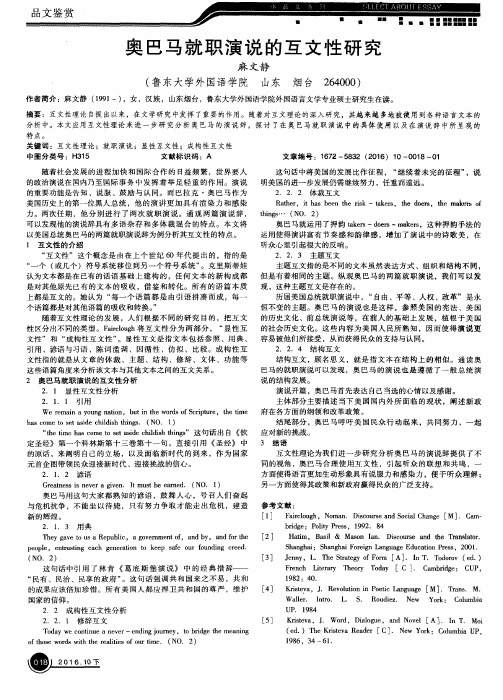
说 的结构 发展 。
演说 开篇 ,奥 巴 马首先 表达 自己当选 的心情 以及 感谢 。 主体 部分 主要 描 述 当 下美 国 国 内外 所 面 临 的现 状 ,阐述 新 政 府在 各方 面 的纲领 和改 革政 策 。 结尾 部分 ,奥 巴 马 呼 吁美 国 民众 行 动 起 来 ,共 同努 力 ,一 起
摘 要 :互文 性理论 自提 出以来 ,在文 学研 究 中发挥 了重要 的作用 。 随着对 互文 理论 的深 入研 究,其 越来 越 多地 被使 用 到 各种 语 言文 本 的 分 析 中。本 文应 用互 文性理 论 来 进 一 步 研 究 分 析 奥 巴马 的 演 说 辞 ,探 讨 了在 奥 巴马 就 职 演说 中 的具 体 使 用 以及 在 演 说 辞 中所 呈 现 的
特点。 关 键词 :互文性 理论 ;就 职演说 ;显性 互文 性 ;成 构性 互文 性 中图分 类号 :H 3 1 5 文献 标 识码 :A 文章 编号 :1 6 7 2— 5 8 3 2( 2 0 1 6 )1 0— 0 0 1 8— 0 1 这 句话 中将 美 国的发展 比作 征程 , “ 继续 着 未 完 的征 程 ” ,说
随着 社会 发 展 的进 程 加 快 和 国 际合 作 的 E l 益 频 繁 ,世 界 要人
的政 治演 说 在 国内乃 至国 际 事 务 中 发 挥 着 举 足 轻重 的作 用 。演说 明美 国的进 一步 发展 仍需 继续努 力 ,任重 而道远 。 的重要 功能 是告 知 、说 服 、鼓 励 与 认 同 。而 巴拉 克 ・ 奥 巴马 作 为 2 .2 .2 体裁 互文
上 都是 互文 的 。她认 为 “ 每 一 个 语 篇 都 是 由 引 语 拼 凑 而 成 ,每 一 个语 篇都是 对其的互 文性 分析 2 . 1 显性 互文 性分 析 2 .1 .1 引用
政治演讲的评价视角——以奥巴马2012胜选演讲为例
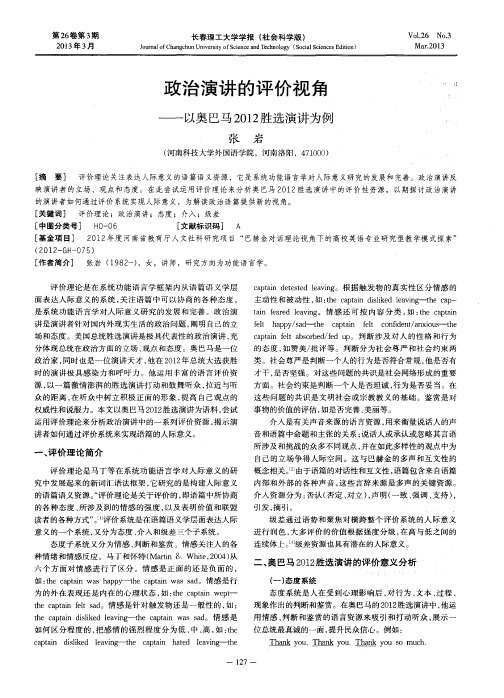
V0 1 . 2 6 No . 3
Ma r . 201 3
政 巴马 2 0 1 2 胜选演讲为例
张 岩
( 河南科技 大学外 国语学 院 ,河南洛阳 ,4 7 1 0 0 0 )
[ 摘 要] 评价理论关注表达人 际意义 的语篇语义 资源 ,它是系统功能语言学对人际意义研 究的发展和完善。政治演讲反
分体 现总统在政治方 面的立场 、 观点和态度 。奥 巴马是一位
c a p t a i n f e l t a b s o r b e d / f e d u p 。判 断 涉 及 对 人 的性 格 和 行 为
的态度 , 如赞 美/ 批评 等 。判 断分为社 会尊严 和社会 约束两
这 些 问 题 的共 识 是 文 明 社 会 或 宗 教 教 义 的 基 础 。鉴 赏 是 对
事物 的价值 的评估 , 如是否完善 、 美丽等 。
介入是 有关 声音来源 的语言 资源 , 用来衡 量说话人的声
讲者 如何通过评价 系统来实 现语 篇的人际意义。
一
音和语篇 中命 题和主张 的关 系 ; 说话人或 承认 或忽略其言语
( 2 01 2 一G H 一07 5)
[ 作者简 介] 张岩 ( 1 9 8 2 - ) ,女 ,讲 师,研 究方 向为功能语言学。
评价理论 是在 系统功 能语 言学框架 内从语 篇语 义学层 面表达人 际意 义的系统 , 关 注语篇 中可 以协 商 的各 种态度 , 是 系统功 能语 言学对人 际意义研 究 的发 展和完 善 。政 治演 c a p t a i n d e t e s t e d l e a v i n g 。根据触 发物 的真实 性区分情 感 的 主 动性和被动 性 , 如: t h e c a p t a i n d i s l i k e d l e a v i n g ' _ t h e c a p — t a i n f e a r e d l e a v i n g 。情 感 还 可按 内容分 类 , 如: t h e c a p t a i n
奥巴马国情咨文 (2)
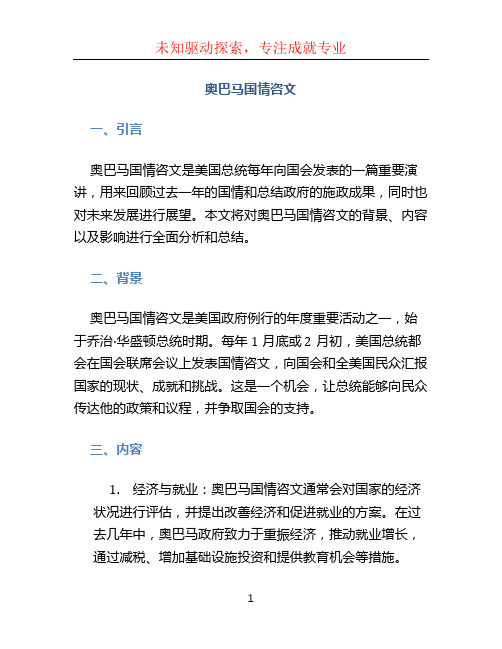
奥巴马国情咨文一、引言奥巴马国情咨文是美国总统每年向国会发表的一篇重要演讲,用来回顾过去一年的国情和总结政府的施政成果,同时也对未来发展进行展望。
本文将对奥巴马国情咨文的背景、内容以及影响进行全面分析和总结。
二、背景奥巴马国情咨文是美国政府例行的年度重要活动之一,始于乔治·华盛顿总统时期。
每年1月底或2月初,美国总统都会在国会联席会议上发表国情咨文,向国会和全美国民众汇报国家的现状、成就和挑战。
这是一个机会,让总统能够向民众传达他的政策和议程,并争取国会的支持。
三、内容1.经济与就业:奥巴马国情咨文通常会对国家的经济状况进行评估,并提出改善经济和促进就业的方案。
在过去几年中,奥巴马政府致力于重振经济,推动就业增长,通过减税、增加基础设施投资和提供教育机会等措施。
2.医疗保健:在奥巴马国情咨文中,医疗保健改革也是一个重要的议题。
奥巴马政府通过“奥巴马医改”(Affordable Care Act)的实施,旨在提供廉价、普惠和可负担的医疗保健服务,为全体美国人提供基本医疗保障。
3.社会公正和平等:奥巴马国情咨文通常也涵盖了促进社会公正和实现平等的重要议题。
他提出了进一步推进种族平等、实现性别平等、保护LGBTQ+权益以及改善移民政策的政策措施。
4.气候变化和环境保护:作为一个重要的国际问题,奥巴马国情咨文也经常涉及到气候变化和环境保护议题。
奥巴马政府致力于推动可持续发展、减少温室气体排放,并签署了巴黎协定,与其他国家合作应对全球气候变化问题。
四、影响奥巴马国情咨文作为美国总统每年的重要演讲之一,对国内外产生了广泛的影响:1.引导政策议程:奥巴马国情咨文通过总统的演讲,向国会和公众提出了政府的政策议程。
演讲中涉及的各项议题是奥巴马政府未来一年将要关注和努力解决的重点。
2.彰显总统领导力:奥巴马国情咨文是总统向国会和全国民众展示领导力和执政能力的一种方式。
演讲中总统的表现将直接影响公众对政府的信任和支持。
奥巴马发表国情咨文 (2)

奥巴马发表国情咨文引言在任美国总统期间,奥巴马发表了许多重要的演讲和咨文,其中包括每年一次的国情咨文。
国情咨文是美国总统向国会和全国人民报告国家现状、提出政策建议的一种重要形式。
本文将对奥巴马发表的国情咨文进行详细分析和解读。
咨文背景奥巴马第一次发表国情咨文是在2009年,当时美国正处于全球金融危机的阴影之下。
这个危机造成了许多国民困境,奥巴马在国情咨文中提出了应对危机的政策,并强调了团结和合作的重要性。
国情咨文分析经济复苏在国情咨文中,奥巴马首先谈到了经济复苏问题。
他指出了危机对美国经济的冲击,并讲述了政府采取的措施来刺激经济增长。
奥巴马提出了一系列的金融改革和经济刺激计划,力图带领美国经济走出困境。
医疗改革奥巴马在国情咨文中也强调了医疗改革的重要性。
他指出美国的医疗保健体系存在许多问题,导致了许多人无法获得负担得起的医疗服务。
奥巴马提出了一套一揽子医疗改革方案,并呼吁国会支持这些改革。
科技创新奥巴马认为科技创新是推动经济增长和社会发展的重要力量。
在国情咨文中,他提出了加大对科技研发的投入,并推动科技创新在各个领域的应用。
奥巴马希望通过科技创新来提高美国的竞争力并创造更多的就业机会。
气候变化奥巴马对气候变化问题非常关注,在国情咨文中他强调了应对气候变化的重要性。
奥巴马提出了一系列的环保政策和减排措施,力图减少碳排放并推动可持续发展。
教育改革奥巴马还在国情咨文中提到了教育改革。
他认为提高教育质量是提升国家竞争力和培养未来人才的关键。
奥巴马提出了一系列的教育改革措施,包括提高教师工资、改善学校设施等。
结论通过分析奥巴马发表的国情咨文,我们可以看到他在总统任期内关注了许多重要问题,并提出了一系列的政策建议。
从经济复苏到医疗改革,从科技创新到气候变化,奥巴马试图推动美国朝着更加繁荣、公正和可持续的方向发展。
国情咨文是奥巴马时期重要的政策传达和沟通方式,也是他治国理政思想和政策的重要体现。
奥巴马的国情咨文对美国产生了深远的影响,不仅在立法过程中起到了重要作用,也影响了全国人民对美国未来发展方向的认识。
奥巴马2012年国情咨文互文性分析
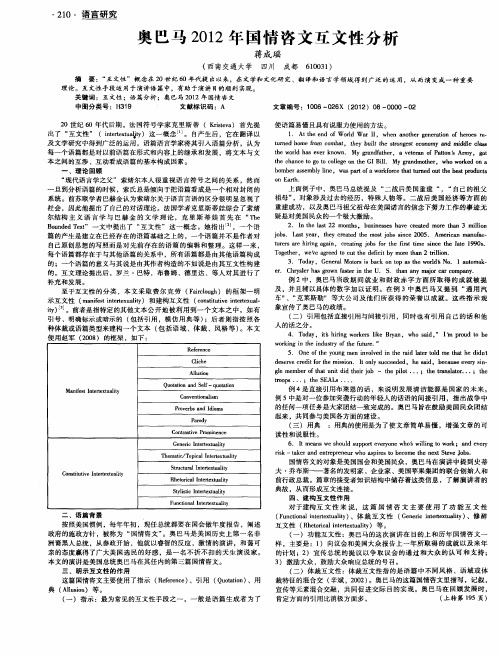
使语篇易懂且具有说服力使用的方法。
1 Att n fW o l . he e d o rd Wa I wh n a oh r g n r t n o e o s r — rI. e n te e eai fh re e o
Re e e c frn e
j s Ls ya,te rae emot oss c 0 5 o . at er hyc tdt s jb i e2 0 .Am r a a ua— b e h n ein m nfe c trr aehr gaan ra n o s f e f i e s c h ae l 9 s ues r i n g i ,ce t gjb o t mtt i e te lt 9 0 . i i rh i m n
一
上面例子中 ,奥巴马总统提及 “ 二战后美国重建 “,“自己的祖父 祖母”,对象涉及过去 的经历 ,特殊人物 等。二战后美 国经济等方 面的 重建成功 ,以及奥 巴马祖父祖母在美 国诺言的信念下努力工作 的事 迹无 疑 是 对美 国 民众 的一 个 极 大 激 励 。
2. I h a t2 n h . b sn s e a e c e td mo e t a l o n t e ls 2 mo t s u i e s s h v r ae r n 3 mi i n h l
篇 的产生是建立在 已经存 在的语篇基础之上的 ,一个语 篇并不是作者对 自己原创思想的写照而是对先前存 在的语篇 的编辑和整 理。这样一来 , 每个语篇都存在于与其他语篇 的关系 中,所有语篇都是由其他语篇构成 的;一个语篇的意义与其说是 由其作者构造的不如说是由其互文性构建 的。互文理论提 出后 ,罗兰 ・ 巴特,布鲁姆 、德里达 、等人对其进行 了 补充和发展 。 至于互文性 的分类 ,本 文采取费 尔克 劳 ( a cog ) 的框 架~ 明 F iluh r 示互文性 ( a is itr xat)和建构互文性 ( ostt eitr xa m n etnet uly f e i cntui et ul i v n e 一 ) 。前者是指特定的其他 文本公 开地被利用 到一个 文本 之中 ,如有 引号 、明确标示或暗示的 ( 包括 引用 ,模仿 用典等 ) ;后者 则指按照各 种体裁或语篇类型来建构一个文本 ( 包括语 域 、体裁 、风格等 ) 。本文 使 用赵军 (0 8 的框架 ,如下 20 )
奥巴马胜选演讲语言风格赏析-精选资料
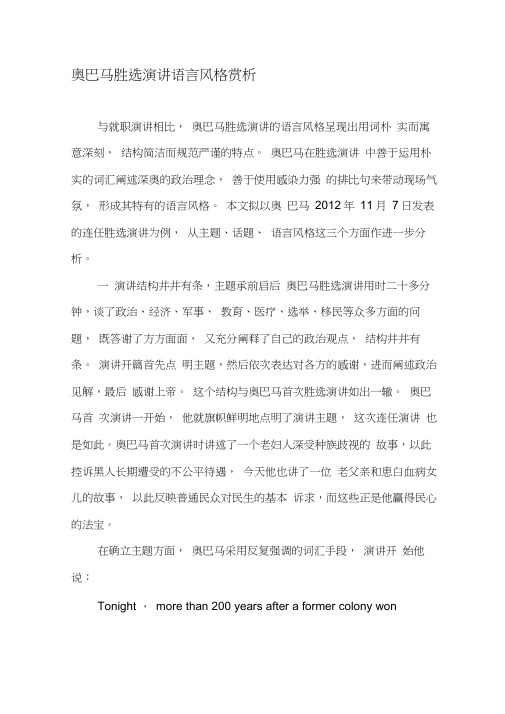
奥巴马胜选演讲语言风格赏析与就职演讲相比,奥巴马胜选演讲的语言风格呈现出用词朴实而寓意深刻,结构简洁而规范严谨的特点。
奥巴马在胜选演讲中善于运用朴实的词汇阐述深奥的政治理念,善于使用感染力强的排比句来带动现场气氛,形成其特有的语言风格。
本文拟以奥巴马2012年11月7日发表的连任胜选演讲为例,从主题、话题、语言风格这三个方面作进一步分析。
一演讲结构井井有条,主题承前启后奥巴马胜选演讲用时二十多分钟,谈了政治、经济、军事、教育、医疗、选举、移民等众多方面的问题,既答谢了方方面面,又充分阐释了自己的政治观点,结构井井有条。
演讲开篇首先点明主题,然后依次表达对各方的感谢,进而阐述政治见解,最后感谢上帝。
这个结构与奥巴马首次胜选演讲如出一辙。
奥巴马首次演讲一开始,他就旗帜鲜明地点明了演讲主题,这次连任演讲也是如此。
奥巴马首次演讲时讲述了一个老妇人深受种族歧视的故事,以此控诉黑人长期遭受的不公平待遇,今天他也讲了一位老父亲和患白血病女儿的故事,以此反映普通民众对民生的基本诉求,而这些正是他赢得民心的法宝。
在确立主题方面,奥巴马采用反复强调的词汇手段,演讲开始他说:Tonight ,more than 200 years after a former colony wonthe right to determine its own destiny ,the task ofperfecting our union moves forward.It moves forward because of you.It moves forward because you reaffirmed the spirit …在此段演讲中奥巴马连续3次使用move forward ,之后反复提起,forward 一词总共说了9次,达到了强调的作用,使之演讲主题与首次的演讲主题密切关联起来,体现了一种承前启后的关系。
奥巴马首次竞选演讲的主题是:Change has come toAmerica。
奥巴马2012国情咨文
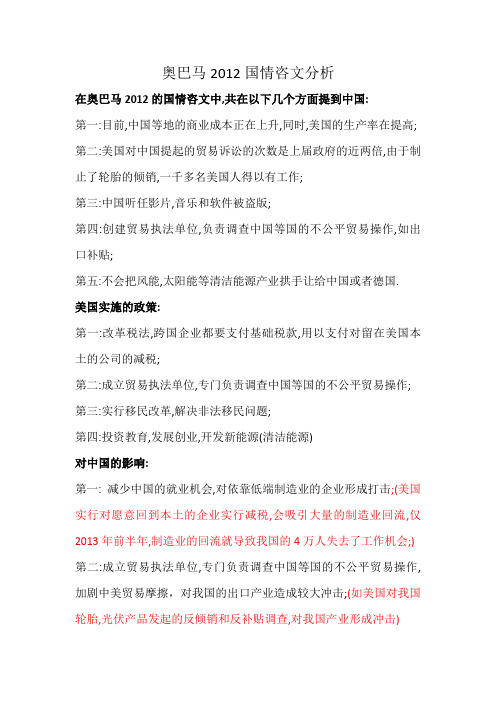
奥巴马2012国情咨文分析在奥巴马2012的国情咨文中,共在以下几个方面提到中国:第一:目前,中国等地的商业成本正在上升,同时,美国的生产率在提高; 第二:美国对中国提起的贸易诉讼的次数是上届政府的近两倍,由于制止了轮胎的倾销,一千多名美国人得以有工作;第三:中国听任影片,音乐和软件被盗版;第四:创建贸易执法单位,负责调查中国等国的不公平贸易操作,如出口补贴;第五:不会把风能,太阳能等清洁能源产业拱手让给中国或者德国.美国实施的政策:第一:改革税法,跨国企业都要支付基础税款,用以支付对留在美国本土的公司的减税;第二:成立贸易执法单位,专门负责调查中国等国的不公平贸易操作; 第三:实行移民改革,解决非法移民问题;第四:投资教育,发展创业,开发新能源(清洁能源)对中国的影响:第一: 减少中国的就业机会,对依靠低端制造业的企业形成打击;(美国实行对愿意回到本土的企业实行减税,会吸引大量的制造业回流,仅2013年前半年,制造业的回流就导致我国的4万人失去了工作机会;) 第二:成立贸易执法单位,专门负责调查中国等国的不公平贸易操作,加剧中美贸易摩擦,对我国的出口产业造成较大冲击;(如美国对我国轮胎,光伏产品发起的反倾销和反补贴调查,对我国产业形成冲击)第三:影响我国装备制造业的升级;(美国力图依靠科技创新打造先进制造业,新兴产业,从而确保美国在制造业的最高端和最高附加值的竞争优势和领导地位,而美国对技术转让一直持保守态度,所以这会延缓我国产业升级,同时我国也会面临发达国家控制先进技术和后起的东南亚,非洲,越南,缅甸等低成本优势的双重打击)第四:美国实行移民改革,通过高薪,高福利待遇吸引优秀人才,会造成我国人才的缺失.美国实行这些政策的原因:第一:解决美国就业问题第二:中美能源等要素成本的比较优势;第三:减少对外贸易逆差,推动美国经济复苏;第四:保持制造业的全球领先优势,重塑美国竞争优势。
中国的应对措施:第一:促进产业转型升级,形成以自主创新为核心的竞争优势;同时吸收国外的先进技术;第二:在技术创新方面,我们可以加大科研投入,加强对科技领域的研发力度;同时依靠科技开发新能源;第三:投资教育,培养高技能人才;关于责任的问题:奥巴马一直强调的要重塑美国的价值观, 主张公平竞争,共担责任;提到08年次贷危机,,银行债务缠身却拿着别人的钱发奖金,监管机构玩忽职守,对不良行为不管不顾,这都是不负责任的,美国的发展需要美国人的责任心.。
奥巴马对华政策分析
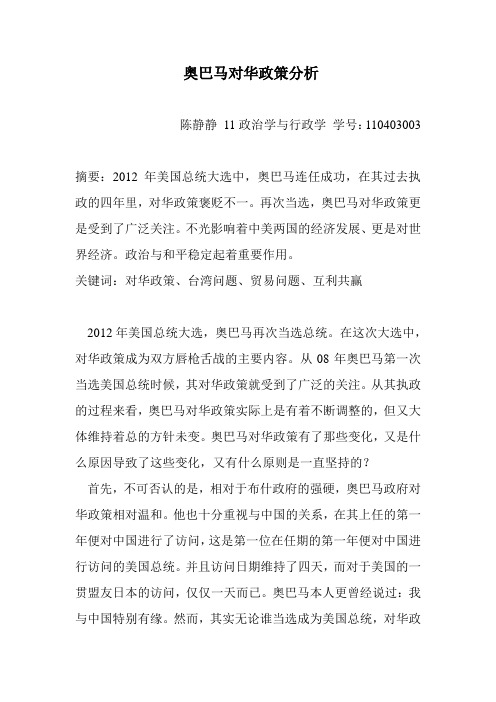
奥巴马对华政策分析陈静静11政治学与行政学学号:110403003摘要:2012年美国总统大选中,奥巴马连任成功,在其过去执政的四年里,对华政策褒贬不一。
再次当选,奥巴马对华政策更是受到了广泛关注。
不光影响着中美两国的经济发展、更是对世界经济。
政治与和平稳定起着重要作用。
关键词:对华政策、台湾问题、贸易问题、互利共赢2012年美国总统大选,奥巴马再次当选总统。
在这次大选中,对华政策成为双方唇枪舌战的主要内容。
从08年奥巴马第一次当选美国总统时候,其对华政策就受到了广泛的关注。
从其执政的过程来看,奥巴马对华政策实际上是有着不断调整的,但又大体维持着总的方针未变。
奥巴马对华政策有了那些变化,又是什么原因导致了这些变化,又有什么原则是一直坚持的?首先,不可否认的是,相对于布什政府的强硬,奥巴马政府对华政策相对温和。
他也十分重视与中国的关系,在其上任的第一年便对中国进行了访问,这是第一位在任期的第一年便对中国进行访问的美国总统。
并且访问日期维持了四天,而对于美国的一贯盟友日本的访问,仅仅一天而已。
奥巴马本人更曾经说过:我与中国特别有缘。
然而,其实无论谁当选成为美国总统,对华政策的根本出发的还是基于对于美国的利益的考虑。
奥巴马对华政策也不可避免的在执行中发生了变化,出现了“当面一套,背后一套”的尴尬处境。
台湾问题仍然是中美关系中最为核心、最为敏感的问题。
奥巴马政府在对台问题上,做出的声明是反对两个中国论,这看似是支持大陆与台湾关系进一步改善。
可是事实上,美国政府继续遵行《与台湾关系法》,在对待台湾问题上的立场并没有发生任何改变。
克林顿国务卿在访华前夕曾明确表示,美国不会放弃对台湾的义务,美国将继续对台军售。
而奥巴马在竞选时候曾经称如果当选会积极推进与中美关系,与中国发展建设性的关系。
不会将中国妖魔化。
可是而后,他又表明,中国既是美国重要的合作伙伴,也是美国的主要竞争对手。
近期内甚至频频出现“中国威胁论”“中国高傲论”等。
奥巴马2012获胜演讲文体学分析
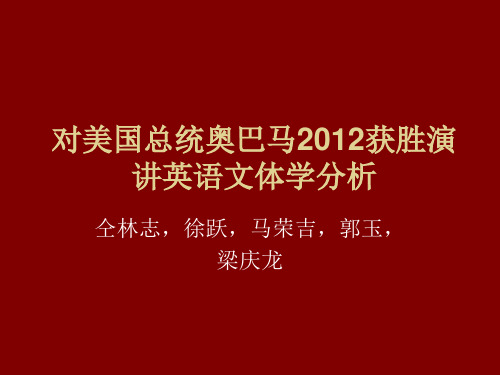
Grammar
Grammar
• On the contrary, the shortest sentence will gain the most powerful audience response. • E.g. • “That’s why we do this. That’s what politics can be. That’s why elections matter. It’s not small, it’s big. who fights for this country ever has to fight for a job or a roof over their head when they come home. • In this sentence, Obama uses a roof over their head to indicate the good life the citizens would live.
vocabulary
• Therefore, it is found this speech is full of spoken words, mostly simple, in order to let the whole country to understand. • Eg: That’s the future we hope for. That’s the vision we share. That’s where we need to go forward. That’s where we need to go. (repetition)
Grammar
• Using appropriate sentence length interchangeably in the speech can arouse audience's feeling.
从互文性角度解读奥巴马总统竞选获胜演讲[论文]
![从互文性角度解读奥巴马总统竞选获胜演讲[论文]](https://img.taocdn.com/s3/m/792dae0a02020740be1e9b1e.png)
从互文性角度解读奥巴马总统竞选获胜演讲摘要:本文分析奥巴马于2012年11月6日发表的总统竞选获胜演讲,通过从互文性角度对政治演讲中的相互指涉的文本进行了对比分析,从而阐述从中展现的美国当代社会的意识。
奥巴马的演讲通过对当下的政治热点和美国特有文化的互文性参照,旨在为其政治目的服务。
关键词:互文性水平互文性垂直互文性社会意识1.引言2012年总统竞选,时任总统奥巴马面对劲敌罗姆尼的强烈冲击,成功连任。
总统竞选作为美国民主、民权精神的重要标志,集中反映了时下美国社会的主要矛盾包括就业、经济、移民、自然灾害救助以及民众利益诉求。
同时,美国历史主流价值包括:种族问题、平等问题、民主自由问题的式微或盛兴的问题在总统竞选过程中也有显现。
互文性理论是由法国批评家kristeva首先提出的。
互文性通常被用来指示两个或两个以上文本间发生的互文关系(陈永国2003:75)。
通过对比历史上美国重要政治人物的优秀演讲,我们可以发现奥巴马竞选获胜演讲含有鲜明的互文性特征。
2.互文性理论和政治演讲特性2.1互文性理论互文性理论起源于bakhtin的文学和语言学理论,尤其是对话理论和异质性理论。
bakhtin认为,对话,即现在说的话语指向过去的和将来的话语,是普遍而基本的,可解释所有话语和其他话语间产生共振和话语组成意识、社会和文化的方式;同时他也认为,语言在其历史存在的任何时刻都是异质体,“它表征了现在和过去之间、过去的不同时代之间、不同的社会意识形态群体之间,不同的倾向性、学派以及集团之间的社会意识形态的矛盾的共存”(李桔元,bakhtin 2008:16)。
互文性分析在语篇分析的基础上kristeva 将互文性分为“水平互文性”和“垂直互文性”,前者是关于一个文本怎样建立在与之具有序列关系的其他文本基础之上。
而后者则关注一个文本怎样建立在纵向构成其直接或间接语境的其他文本基础之上(李桔元 2008:17)。
2.2政治演讲特性政治演讲,作为一种重要的政治语篇,通过具有一定社会地位并代表国家意志的演讲者针对内政与外交等方面向公众表明立场、宣传主张以及阐明观点的一种演说。
奥巴马发表2012年国情咨文
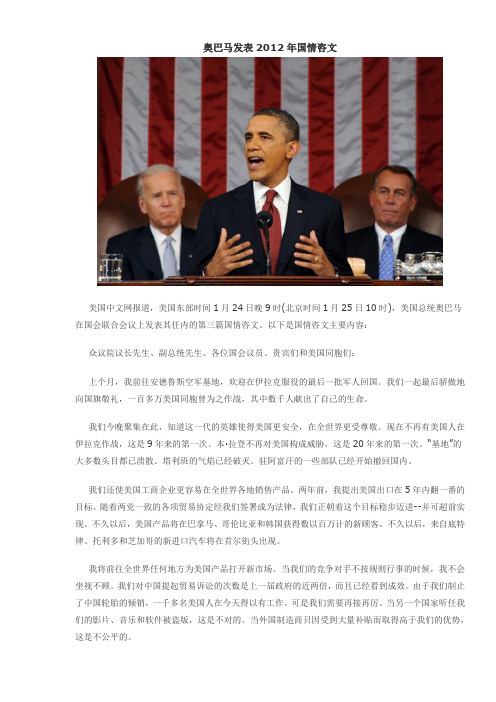
奥巴马发表2012年国情咨文美国中文网报道,美国东部时间1月24日晚9时(北京时间1月25日10时),美国总统奥巴马在国会联合会议上发表其任内的第三篇国情咨文。
以下是国情咨文主要内容:众议院议长先生、副总统先生、各位国会议员、贵宾们和美国同胞们:上个月,我前往安德鲁斯空军基地,欢迎在伊拉克服役的最后一批军人回国。
我们一起最后骄傲地向国旗敬礼,一百多万美国同胞曾为之作战,其中数千人献出了自己的生命。
我们今晚聚集在此,知道这一代的英雄使得美国更安全,在全世界更受尊敬。
现在不再有美国人在伊拉克作战,这是9年来的第一次。
本·拉登不再对美国构成威胁,这是20年来的第一次。
―基地‖的大多数头目都已溃散。
塔利班的气焰已经破灭。
驻阿富汗的一些部队已经开始撤回国内。
我们还使美国工商企业更容易在全世界各地销售产品。
两年前,我提出美国出口在5年内翻一番的目标。
随着两党一致的各项贸易协定经我们签署成为法律,我们正朝着这个目标稳步迈进--并可超前实现。
不久以后,美国产品将在巴拿马、哥伦比亚和韩国获得数以百万计的新顾客。
不久以后,来自底特律、托利多和芝加哥的新进口汽车将在首尔街头出现。
我将前往全世界任何地方为美国产品打开新市场。
当我们的竞争对手不按规则行事的时候,我不会坐视不顾。
我们对中国提起贸易诉讼的次数是上一届政府的近两倍,而且已经看到成效。
由于我们制止了中国轮胎的倾销,一千多名美国人在今天得以有工作。
可是我们需要再接再厉。
当另一个国家听任我们的影片、音乐和软件被盗版,这是不对的。
当外国制造商只因受到大量补贴而取得高于我们的优势,这是不公平的。
今晚,我宣布创建一个―贸易执法单位‖,负责调查中国等国的不公平贸易作法。
我们将加强检验,防止假冒或者不安全的商品跨越边境进入我国。
本届国会应做到勿使外国公司在取得融资或者进入俄罗斯等新市场方面取得高于美国制造商的优势。
结束伊拉克战争让我们能够给我们的敌人以致命的打击。
从巴基斯坦到也门,残余的―基地‖组织成员仓皇失措,知道自己无法逃脱美利坚合众国的天网。
奥巴马获胜演讲 译文与评论原文及翻译
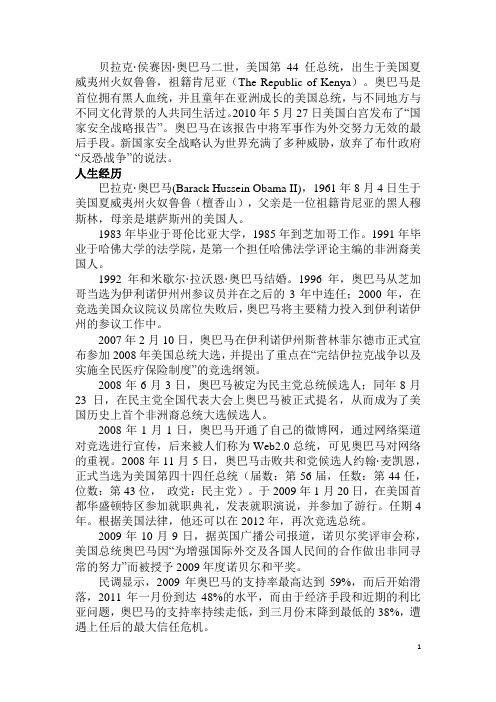
贝拉克·侯赛因·奥巴马二世,美国第44任总统,出生于美国夏威夷州火奴鲁鲁,祖籍肯尼亚(The Republic of Kenya)。
奥巴马是首位拥有黑人血统,并且童年在亚洲成长的美国总统,与不同地方与不同文化背景的人共同生活过。
2010年5月27日美国白宫发布了“国家安全战略报告”。
奥巴马在该报告中将军事作为外交努力无效的最后手段。
新国家安全战略认为世界充满了多种威胁,放弃了布什政府“反恐战争”的说法。
人生经历巴拉克·奥巴马(Barack Hussein Obama II),1961年8月4日生于美国夏威夷州火奴鲁鲁(檀香山),父亲是一位祖籍肯尼亚的黑人穆斯林,母亲是堪萨斯州的美国人。
1983年毕业于哥伦比亚大学,1985年到芝加哥工作。
1991年毕业于哈佛大学的法学院,是第一个担任哈佛法学评论主编的非洲裔美国人。
1992年和米歇尔·拉沃恩·奥巴马结婚。
1996年,奥巴马从芝加哥当选为伊利诺伊州州参议员并在之后的3年中连任;2000年,在竞选美国众议院议员席位失败后,奥巴马将主要精力投入到伊利诺伊州的参议工作中。
2007年2月10日,奥巴马在伊利诺伊州斯普林菲尔德市正式宣布参加2008年美国总统大选,并提出了重点在“完结伊拉克战争以及实施全民医疗保险制度”的竞选纲领。
2008年6月3日,奥巴马被定为民主党总统候选人;同年8月23日,在民主党全国代表大会上奥巴马被正式提名,从而成为了美国历史上首个非洲裔总统大选候选人。
2008年1月1日,奥巴马开通了自己的微博网,通过网络渠道对竞选进行宣传,后来被人们称为Web2.0总统,可见奥巴马对网络的重视。
2008年11月5日,奥巴马击败共和党候选人约翰·麦凯恩,正式当选为美国第四十四任总统(届数:第56届,任数:第44任,位数:第43位,政党:民主党)。
于2009年1月20日,在美国首都华盛顿特区参加就职典礼,发表就职演说,并参加了游行。
中美经济振兴政策管窥——读奥巴马2012国情咨文有感
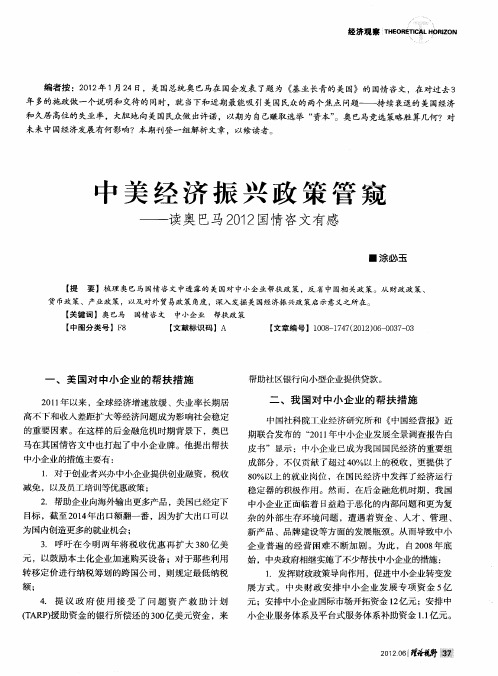
杂 的外 部生存环境 问题 ,遭 遇着 资金 、人才 、管理 、 新产品 、品牌建设 等方面 的发展瓶颈 。从而导致 中小 企业 普遍 的经 营困难不 断加剧 。为此 ,自2 0 年底 08 始 ,中央政府相继实施 了不少帮扶 中小企业的措施 : 1 .发挥财政政策导 向作用 ,促进中小企业转变发 展 方 式 。 中央财 政安 排 中小 企业 发 展 专项 资金 5 亿 元 ;安排 中小企业 国际市场开拓资金 1 亿元 ;安排 中 2
2 .为帮助企业 向海外输出更多产品 ,自2 0 年 6 08 月 开始 ,相继 提高 了一些 优势 产 品 、劳 动密 集型 产
作将更加制度化 、系统化 。
品 、高技术含量产品和深加工产品 ,以及其他受 到影
响 比较大 的产 品出 口退税率 。如纺织 品服装 的出口退
税率 2 0 年 8 08 月起由 1 %调整到 1% ;2 0 年 1月提 1 3 08 1
减免 ,以及员工培训等优惠政策 ;
期联合发布 的 “0 中小企业发展全景调查报告 白 2 年 1 1 皮书 ”显示 :中小企业 已成为我国 国民经济的重要组
成部分 ,不仅 贡献 了超过 4 %以上的税 收 ,更提供 了 0
8 %以上的就业 岗位 ,在 国民经济 中发挥 了经 济运行 0
三、美国政策对我们的启示
综观奥 巴马 国情 咨文所透露 的经济振兴措施 ,总
至 1%;2 0 年 2 4 09 月再提 到 1%;从 2 0 年 4 5 09 月起 , 出 口退税 率达到 1%。从 1%到 1%,不到一年 的时 6 1 6 间里上升 5 百分点 ,纺织服装行业 出口退税率 “ 个 小 步快跑”的节奏 ,正显示 出中央政府逐步制定和出台 支持出口发展 的政策信号。 3 .为应对全球金融危机对经济发展所产生 的恶劣 影响 ,国家及时推 出了增值税转型改革 ,将增值税 从 生产型转为消费型。从 2 0 年开始 ,允许全 国所有增 09
互文性视角下的奥巴马就职演说
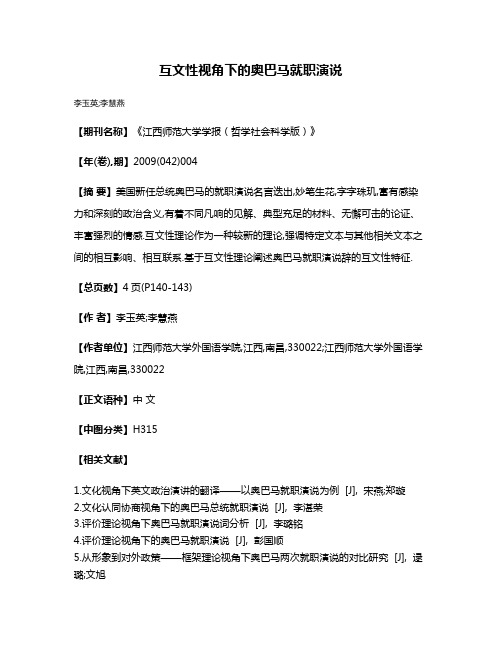
互文性视角下的奥巴马就职演说
李玉英;李慧燕
【期刊名称】《江西师范大学学报(哲学社会科学版)》
【年(卷),期】2009(042)004
【摘要】美国新任总统奥巴马的就职演说名言迭出,妙笔生花,字字珠玑,富有感染力和深刻的政治含义,有着不同凡响的见解、典型充足的材料、无懈可击的论证、丰富强烈的情感.互文性理论作为一种较新的理论,强调特定文本与其他相关文本之间的相互影响、相互联系.基于互文性理论阐述奥巴马就职演说辞的互文性特征.【总页数】4页(P140-143)
【作者】李玉英;李慧燕
【作者单位】江西师范大学外国语学院,江西,南昌,330022;江西师范大学外国语学院,江西,南昌,330022
【正文语种】中文
【中图分类】H315
【相关文献】
1.文化视角下英文政治演讲的翻译——以奥巴马就职演说为例 [J], 宋燕;郑璇
2.文化认同协商视角下的奥巴马总统就职演说 [J], 李湛荣
3.评价理论视角下奥巴马就职演说词分析 [J], 李璐铭
4.评价理论视角下的奥巴马就职演说 [J], 彭国顺
5.从形象到对外政策——框架理论视角下奥巴马两次就职演说的对比研究 [J], 逯璐;文旭
因版权原因,仅展示原文概要,查看原文内容请购买。
奥巴马发表国情咨文
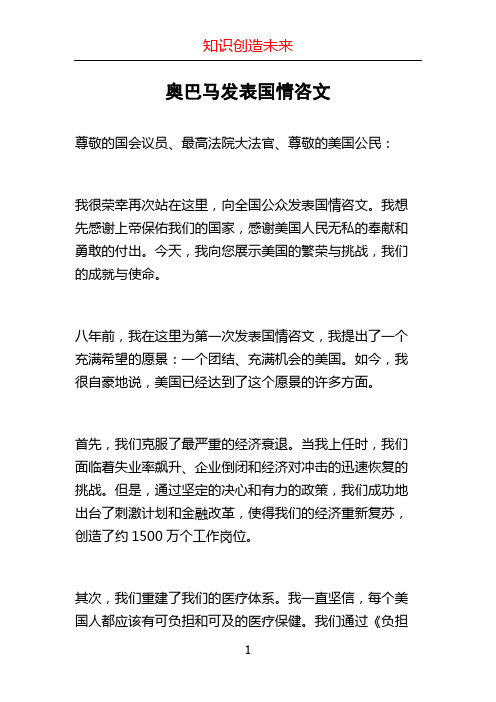
奥巴马发表国情咨文尊敬的国会议员、最高法院大法官、尊敬的美国公民:我很荣幸再次站在这里,向全国公众发表国情咨文。
我想先感谢上帝保佑我们的国家,感谢美国人民无私的奉献和勇敢的付出。
今天,我向您展示美国的繁荣与挑战,我们的成就与使命。
八年前,我在这里为第一次发表国情咨文,我提出了一个充满希望的愿景:一个团结、充满机会的美国。
如今,我很自豪地说,美国已经达到了这个愿景的许多方面。
首先,我们克服了最严重的经济衰退。
当我上任时,我们面临着失业率飙升、企业倒闭和经济对冲击的迅速恢复的挑战。
但是,通过坚定的决心和有力的政策,我们成功地出台了刺激计划和金融改革,使得我们的经济重新复苏,创造了约1500万个工作岗位。
其次,我们重建了我们的医疗体系。
我一直坚信,每个美国人都应该有可负担和可及的医疗保健。
我们通过《负担得起的医疗保健法案》实现了这一目标,为数百万无保险人口提供了医疗保险,并保护了数百万现有的医疗保险。
我们还进行了历史性的进步,推进了LGBTQ权益。
我们废除了“不问不说”政策,允许同性恋和双性恋者在军队中自由表达自己的身份。
同性婚姻合法化,并且司法部门对待LGBTQ权益的态度也发生了巨大变化。
这些成就的背后是不可忽视的挑战。
我们仍然面临着全球恐怖主义威胁,如伊斯兰国和基地组织。
我们必须更加努力地保护国家安全,打击恐怖分子的威胁,同时保持我们美国价值观的核心。
我们还必须要解决和应对气候变化的挑战。
科学告诉我们,气候变化是现实,并且可能带来灾难性的后果。
我们必须采取行动减少温室气体排放,推动可再生能源的发展,并加强全球合作以应对这一挑战。
此外,我们还必须坚持对待移民问题的公正和人道的态度。
我们的移民制度需要进行全面的改革,以使得合法渠道更加容易,同时遏制非法移民。
我们必须建设一个让每个人有机会实现美国梦的社会。
最后,我们必须继续努力实现种族平等和社会正义。
我们在过去几年中见证了一系列种族动荡事件,这再次提醒我们,我们的工作尚未完成。
美国总统奥巴马2012国情咨文
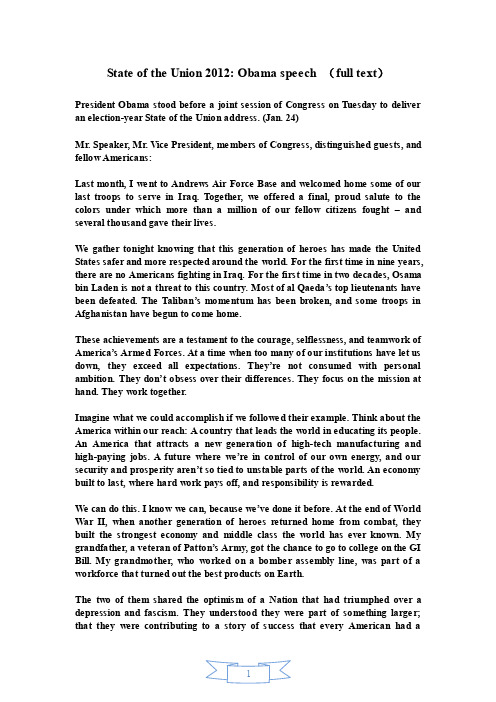
State of the Union 2012: Obama speech (full text)President Obama stood before a joint session of Congress on Tuesday to deliver an election-year State of the Union address. (Jan. 24)Mr. Speaker, Mr. Vice President, members of Congress, distinguished guests, and fellow Americans:Last month, I went to Andrews Air Force Base and welcomed home some of our last troops to serve in Iraq. Together, we offered a final, proud salute to the colors under which more than a million of our fellow citizens fought –and several thousand gave their lives.W e gather tonight knowing that this generation of heroes has made the United States safer and more respected around the world. For the first time in nine years, there are no Americans fighting in Iraq. For the first time in two decades, Osama bin Laden is not a threat to this country. Most of al Qaeda’s top lieutenants have been defeated. The Taliban’s momentum has been broken, and some troops in Afghanistan have begun to come home.These achievements are a testament to the courage, selflessness, and teamwork of America’s Armed Forces. At a time when too many of our institutions have let us down, they exceed all expectations. They’re not consumed with personal ambition. They don’t obsess over their differences. They focus on the mission at hand. They work together.Imagine what we could accomplish if we followed their example. Think about the America within our reach: A country that leads the world in educating its people. An America that attracts a new generation of high-tech manufacturing and high-paying jobs. A future where we’re in control of our own energy, and our security and prosperity aren’t so tied to unstable parts of the world. An economy built to last, where hard work pays off, and responsibility is rewarded.W e can do this. I know we can, because we’ve done it before. At the end of World W ar II, when another generation of heroes r eturned home from combat, they built the strongest economy and middle class the world has ever known. My grandfather, a vet eran of Patton’s Army, got the chance to go to college on the GI Bill. My grandmother, who worked on a bomber assembly line, was part of a workforce that turned out the best products on Earth.The two of them shared the optimism of a Nation that had triumphed over a depression and fascism. They understood they were part of something larger; that they were contributing to a story of success that every American had achance to share – the basic American promise that if you worked hard, you could do well enough to raise a family, own a home, send your kids to college, and put a little away for retirement.The defining issue of our time is how to keep that promise alive. No challenge is more urgent. No debate is more important. W e can either settle for a country where a shrinking number of people do really well, while a growing number of Americans barely get by. Or we can restore an economy where everyone gets a fair shot, everyone does their fair share, and everyone plays by the same set of rules. What’s at stake are not Democratic values or Republican values, but American values. W e have to reclaim them.Let’s remember how we got here. Long before the recession, jobs and manufacturing began leaving our shores. T echnology made businesses more efficient, but also made some jobs obsolete. Folks at the top saw their incomes rise like never before, but most hardworking Americans struggled with costs that were growing, paychecks that weren’t, and personal debt that kept piling up.In 2008, the house of cards collapsed. W e learned that mortgages had been sold to people who couldn’t afford or understand them. Banks had made huge bets and bonuses with other people’s money. Regulators had looked the other way, or didn’t have the authority to stop the bad behavior.It was wrong. It was irresponsible. And it plunged our economy into a crisis that put millions out of work, saddled us with more debt, and left innocent, hard-working Americans holding the bag. In the six months before I took office, we lost nearly four million jobs. And we lost another four million before our policies were in full effect.Those are the facts. But so are these. In the last 22 months, businesses have created more than three million jobs. Last year, they created the most jobs since 2005. American manufacturers are hiring again, creating jobs for the first time since the late 1990s. Together, we’ve agreed to cut the deficit by more than $2 trillion. And we’ve put in place new rules to hold W all Street accountable, so a crisis like that never happens again.The state of our Union is getting stronger. And we’ve come too far to turn back now. As long as I’m President, I will work with anyone in this chamber to build on this momentum. But I intend to fight obstruction with action, and I will oppose any effort to return to the very same policies that brought on this economic crisis in the first place.No, we will not go back to an economy weakened by outsourcing, bad debt, and phony financial profits. Tonight, I want to speak about how we move forwa rd, and lay out a blueprint for an economy that’s built to last – an economy built on American manufacturing, American energy, skills for American workers, and a renewal of American values.This blueprint begins with American manufacturing.On the day I took office, our auto industry was on the verge of collapse. Some even said we should let it die. With a million jobs at stake, I refused to let that happen. In exchange for help, we demanded responsibility. W e got workers and automakers to settle their differences. W e got the industry to retool and restructure. Today, General Motors is back on top as the world’s number one automaker. Chrysler has grown faster in the U.S. than any major car company. Ford is investing billions in U.S. plants and factories. And together, the entire industry added nearly 160,000 jobs.W e bet on American workers. W e bet on American ingenuity. And tonight, the American auto industry is back.What’s happening in Detroit can happen in other industries. It can happen in Clevel and and Pittsburgh and Raleigh. W e can’t bring back every job that’s left our shores. But right now, it’s getting more expensive to do business in places like China. Meanwhile, America is more productive. A few weeks ago, the CEO of Master Lock told me that it now makes business sense for him to bring jobs back home. Today, for the first time in fifteen years, Master Lock’s unionized plant in Milwaukee is running at full capacity.So we have a huge opportunity, at this moment, to bring manufacturing back. But we have to seize it. Tonight, my message to business leaders is simple: Ask yourselves what you can do to bring jobs back to your country, and your country will do everything we can to help you succeed.W e should start with our tax code. Right now, companies get tax breaks for moving jobs and profits overseas. Meanwhile, companies that choose to stay in America get hit with one of the highest tax rates in the world. It makes no sense, and everyone knows it.So let’s change it. First, if you’re a bus iness that wants to outsource jobs, you shouldn’t get a tax deduction for doing it. That money should be used to cover moving expenses for companies like Master Lock that decide to bring jobs home.Second, no American company should be able to avoid paying its fair share of taxes by moving jobs and profits overseas. From now on, every multinational company should have to pay a basic minimum tax. And every penny should go towards lowering taxes for companies that choose to stay here and hire here.Third, if you’re an American manufacturer, you should get a bigger tax cut. Ifyou’re a high-tech manufacturer, we should double the tax deduction you get for making products here. And if you want to relocate in a community that was hit hard when a factory left town, you should get help financing a new plant, equipment, or training for new workers.My message is simple. It’s time to stop rewarding businesses that ship jobs overseas, and start rewarding companies that create jobs right here in America. Send me t hese tax reforms, and I’ll sign them right away.W e’re also making it easier for American businesses to sell products all over the world. Two years ago, I set a goal of doubling U.S. exports over five years. With the bipartisan trade agreements I signed into law, we are on track to meet that goal –ahead of schedule. Soon, there will be millions of new customers for American goods in Panama, Colombia, and South Korea. Soon, there will be new cars on the streets of Seoul imported from Detroit, and Toledo, and Chicago.I will go anywhere in the world to open new markets for American products. And I will not stand by when our competitors don’t play by the rules. W e’ve brought trade cases against China at nearly twice the rate as the last administration –an d it’s made a difference. Over a thousand Americans are working today because we stopped a surge in Chinese tires. But we need to do more. It’s not right when another country lets our movies, music, and software be pirated. It’s not fair when foreign manuf acturers have a leg up on ours only because they’re heavily subsidized.Tonight, I’m announcing the creation of a Trade Enforcement Unit that will be charged with investigating unfair trade practices in countries like China. There will be more inspections to prevent counterfeit or unsafe goods from crossing our borders. And this Congress should make sure that no foreign company has an advantage over American manufacturing when it comes to accessing finance or new markets like Russia. Our workers are the most productive on Earth, and if the playing field is level, I promise you – America will always win.I also hear from many business leaders who want to hire in the United States but can’t find workers with the right skills. Growing industries in science and technology have twice as many openings as we have workers who can do the job. Think about that –openings at a time when millions of Americans are looking for work.That’s inexcusable. And we know how to fix it.Jackie Bray is a single mom from North Carolina who was laid off from her job as a mechanic. Then Siemens opened a gas turbine factory in Charlotte, and formed a partnership with Central Piedmont Community College. The companyhelped the college design courses in laser and robotics training. It paid Jackie’s tuition, then hired her to help operate their plant.I want every American looking for work to have the same opportunity as Jackie did. Join me in a national commitment to train two million Americans with skills that will lead directly to a job. My Administration has already lined up more companies that want to help. Model partnerships between businesses like Siemens and community colleges in places like Charlotte, Orlando, and Louisville are up and running. Now you need to give more community colleges the resources they need to become community career centers – places that teach people skills that local businesses are looking for right now, from data management to high-tech manufacturing.And I want to cut through the maze of confusing training programs, so that from now on, people like Jackie have one program, one website, and one place to go for all the information and help they need. It’s time to turn our unemployment system into a reemployment system that puts people to work.These reforms will help people get jobs that are open today. But to prepare for the jobs of tomorrow, our commitment to skills and education has to start earlier.For less than one percent of what our Nation spends on education each year, we’ve convinced nearly every State in the country to raise their standards for teaching and learning –the first time that’s happened in a generation.But challenges remain. And we know how to solve them.At a time when other countries are doubling down on education, tight budgets have forced States to lay off thousands of teachers. W e know a good teacher can increase the lifetime income of a classroom by over $250,000. A great teacher can offer an escape from poverty to the child who dreams beyond his circumstance. Every person in this chamber can point to a teacher who changed the trajectory of their lives. Most teachers work tirelessly, with modest pay, sometimes digging into their own pocket for school supplies – just to make a difference.Teachers matter. So instead of bashing them, or defending the status quo, let’s offer schools a deal. Give them the resources to keep good teachers on the job, and reward the best ones. In return, grant schools flexibility: To teach with creativity and passion; to stop teaching to the test; and to replace teachers who just aren’t helping kids learn.W e also know that when students aren’t allowed to walk away from their education, more of them walk the stage to get their diploma. So tonight, I call on every State to require that all students stay in high school until they graduate or turn eighteen.When kids do graduate, the most daunting challenge can be the cost of college. At a time when Americans owe more in tuition debt than credit card debt, this Congress needs to stop the interest rates on student loans from doubling in July. Extend the tuition tax credit we started that saves middle-class families thousands of dollars. And give more young people the chance to earn their way through college by doubling the number of work-study jobs in the next five years.Of course, it’s not enough for us to increase student aid. W e can’t just keep subsidizing skyrocketing tuition; we’ll run out of money. States also need to do their part, by making higher education a higher priority in their budge ts. And colleges and universities have to do their part by working to keep costs down. Recently, I spoke with a group of college presidents who’ve done just that. Some schools re-design courses to help students finish more quickly. Some use better technolo gy. The point is, it’s possible. So let me put colleges and universities on notice: If you can’t stop tuition from going up, the funding you get from taxpayers will go down. Higher education can’t be a luxury –it’s an economic imperative that every family in America should be able to afford.Let’s also remember that hundreds of thousands of talented, hardworking students in this country face another challenge: The fact that they aren’t yet American citizens. Many were brought here as small children, are American through and through, yet they live every day with the threat of deportation. Others came more recently, to study business and science and engineering, but as soon as they get their degree, we send them home to invent new products and create new jobs somewhere else.That doesn’t make sense.I believe as strongly as ever that we should take on illegal immigration. That’s why my Administration has put more boots on the border than ever before. That’s why there are fewer illegal crossings than when I took office.The opponents of action are out of excuses. W e should be working on comprehensive immigration reform right now. But if election-year politics keeps Congress from acting on a comprehensive plan, let’s at least agree to stop expelling responsible young people who want to staff our labs, start new businesses, and defend this country. Send me a law that gives them the chance to earn their citizenship. I will sign it right away.Y ou see, an economy built to last is one where we encourage the talent and ingenuity of every person in this country. That means women should earn equalpay for equal work. It means we should support everyone who’s willing to work; and every risk-taker and entrepreneur who aspires to become the next Steve Jobs.After all, innovation is what America has always been about. Most new jobs are created in start-ups and small businesses. So let’s pass an agenda that helps them succeed. Tear down regulations that prevent aspiring entrepreneurs from getting the financing to grow. Expand tax relief to small businesses that are raising wages and creating good jobs. Both parties agree on these ideas. So put them in a bill, and get it on my desk this year.Innovation also demands basic research. Today, the discoveries taking place in our federally-financed labs and universities could lead to new treatments that kill cancer cells but leave healthy ones untouched. New lightweight vests for cops and soldiers that can stop any bullet. Don’t gut these investments in our budget. Don’t le t other countries win the race for the future. Support the same kind of research and innovation that led to the computer chip and the Internet; to new American jobs and new American industries.Nowhere is the promise of innovation greater than in American-made energy. Over the last three years, we’ve opened millions of new acres for oil and gas exploration, and tonight, I’m directing my Administration to open more than 75 percent of our potential offshore oil and gas resources. Right now, American oil pro duction is the highest that it’s been in eight years. That’s right – eight years. Not only that –last year, we relied less on foreign oil than in any of the past sixteen years.But with only 2 percent of the world’s oil reserves, oil isn’t enough. This country needs an all-out, all-of-the-above strategy that develops every available source of American energy –a strategy that’s cleaner, cheaper, and full of new jobs.W e have a supply of natural gas that can last America nearly one hundred years, and my Administration will take every possible action to safely develop this energy. Experts believe this will support more than 600,000 jobs by the end of the decade. And I’m requiring all companies that drill for gas on public lands to disclose the chemicals they use. America will develop this resource without putting the health and safety of our citizens at risk.The development of natural gas will create jobs and power trucks and factories that are cleaner and cheaper, proving that we don’t have to choose be tween our environment and our economy. And by the way, it was public research dollars, over the course of thirty years, that helped develop the technologies to extract all this natural gas out of shale rock –reminding us that Government support is critical in helping businesses get new energy ideas off the ground.What’s true for natural gas is true for clean energy. In three years, our partnership with the private sector has already positioned America to be the world’s leading manufacturer of high-tech batteries. Because of federal investments, renewable energy use has nearly doubled. And thousands of Americans have jobs because of it.When Bryan Ritterby was laid off from his job making furniture, he said he worried that at 55, no one would give him a second chance. But he found work at Energetx, a wind turbine manufacturer in Michigan. Before the recession, the factory only made luxury yachts. Today, it’s hiring workers like Bryan, who said, “I’m proud to be working in the industry of the future.”Our experience with shale gas shows us that the payoffs on these public investments don’t always come right away. Some technologies don’t pan out; some companies fail. But I will not walk away from the promise of clean energy. I will not walk away from workers like Bryan. I will not cede the wind or solar or battery industry to China or Germany because we refuse to make the same commitment here. W e have subsidized oil companies for a century. That’s long enough. It’s time to end the taxpayer giveaways to an industry that’s rarely been more profitable, and double-down on a clean energy industry that’s never been more promising. Pass clean energy tax credits and create these jobs.W e can also spur energy innovation with new incentives. The differences in this chamber may be too deep right now to pass a comprehensive plan to fight climate change. But there’s no reason why Congress shouldn’t at least set a clean energy standard that creates a market for innovation. So far, you haven’t acted. W ell tonight, I will. I’m directing my Administration to allow the development of clean energy on enough public land to power three million homes. And I’m proud to announce that the Department of Defense, the world’s largest consumer of energy, will make one of the largest commitments to clean energy in history –with the Navy purchasing enough capacity to power a quarter of a million homes a year.Of course, the easiest way to save money is to waste less energy. So here’s another proposal: Help manufacturers eliminate energy waste in their factories and give businesses incentives to upgrade their buildings. Their energy bills will be $100 billion lower over the next decade, and America will have less pollution, more manufacturing, and more jobs for construction workers who need them. Send me a bill that creates these jobs.Building this new energy future should be just one part of a broader agenda to repair America’s infrastructure. So much of America needs to be rebuilt. W e’ve got crumbling roads and bridges. A power grid that wastes too much energy. Anincomplete high-speed broadband network that prevents a small business owner in rural America from selling her products all over the world.During the Great Depression, America built the Hoover Dam and the Golden Gate Bridge. After World War II, we connected our States with a system of highways. Democratic and Republican administrations invested in great projects that benefited everybody, from the workers who built them to the businesses that still use them today.In the next few weeks, I will sign an Executive Order clearing away the red tape that slows down too many construction projects. But you need to fund these projects. Take the money we’re no longer spending at war, use half of it to pay down our debt, and use the rest to do some nation-building right here at home.There’s never been a better time to build, especially since the construction industry was one of the hardest-hit when the housing bubble burst. Of course, construction workers weren’t the only ones hurt. So were millions of innocent Americans who’ve seen their home values decline. And while Government can’t fix the problem on its own, responsible homeowners shouldn’t have to sit and wait for the housing market to hit bottom to get some relief.That’s why I’m sending this Congress a plan that gives every responsible homeowner the chance to save about $3,000 a year on their mortgage, by refinancing at historically low interest rates. No more red tape. No more runaround from the banks. A small fee on the largest financial institutions will ensure that it won’t add to the deficit, and will give banks that were rescued by taxpayers a chance to repay a deficit of trust.Let’s never forget: Millions of Americans who work hard and play by the rules every day dese rve a Government and a financial system that do the same. It’s time to apply the same rules from top to bottom: No bailouts, no handouts, and no copouts. An America built to last insists on responsibility from everybody.W e’ve all paid the price for lenders who sold mortgages to people who couldn’t afford them, and buyers who knew they couldn’t afford them. That’s why we need smart regulations to prevent irresponsible behavior. Rules to prevent financial fraud, or toxic dumping, or faulty medical devices, don’t destroy the free market. They make the free market work better.There is no question that some regulations are outdated, unnecessary, or too costly. In fact, I’ve approved fewer regulations in the first three years of my presidency than my Republi can predecessor did in his. I’ve ordered every federal agency to eliminate rules that don’t make sense. W e’ve already announced over 500 reforms, and just a fraction of them will save business and citizens more than$10 billion over the next five years. W e got rid of one rule from 40 years ago that could have forced some dairy farmers to spend $10,000 a year proving that they could contain a spill – because milk was somehow classified as an oil. With a rule like that, I guess it was worth crying over spilled milk.I’m confident a farmer can contain a milk spill without a federal agency looking over his shoulder. But I will not back down from making sure an oil company can contain the kind of oil spill we saw in the Gulf two years ago. I will not back down from protecting our kids from mercury pollution, or making sure that our food is safe and our water is clean. I will not go back to the days when health insurance companies had unchecked power to cancel your policy, deny you coverage, or charge women differently from men.And I will not go back to the days when W all Street was allowed to play by its own set of rules. The new rules we passed restore what should be any financial system’s core purpose: Getting funding to entrepreneurs with the best ideas, an d getting loans to responsible families who want to buy a home, start a business, or send a kid to college.So if you’re a big bank or financial institution, you are no longer allowed to make risky bets with your customers’ deposits. Y ou’re required to write out a “living will” that details exactly how you’ll pay the bills if you fail –because the rest of us aren’t bailing you out ever again. And if you’re a mortgage lender or a payday lender or a credit card company, the days of signing people up for products they can’t afford with confusing forms and deceptive practices are over. Today, American consumers finally have a watchdog in Richard Cordray with one job: To look out for them.W e will also establish a Financial Crimes Unit of highly trained investigators to crack down on large-scale fraud and protect people’s investments. Some financial firms violate major anti-fraud laws because there’s no real penalty for being a repeat offender. That’s bad for consumers, and it’s bad for the vast majority of bankers and financial service professionals who do the right thing. So pass legislation that makes the penalties for fraud count.And tonight, I am asking my Attorney General to create a special unit of federal prosecutors and leading state attorneys general to expand our investigations into the abusive lending and packaging of risky mortgages that led to the housing crisis. This new unit will hold accountable those who broke the law, speed assistance to homeowners, and help turn the page on an era of recklessness that hurt so many Americans.A return to the American values of fair play and shared responsibility will help us protect our people and our economy. But it should also guide us as we look topay down our debt and invest in our future.Right now, our most immediate priority is stopping a tax hike on 160 million working Americans while the recovery is still fragile. People cannot afford losing $40 out of each paycheck this year. There are plenty of ways to get this done. So let’s agree right here, right now: No side issues. No drama. Pass the payroll tax cut without delay.When it comes to the deficit, we’ve already agreed to more than $2 trillion in cuts and savings. But we need to do more, and that means making choices. Right now, we’re poised t o spend nearly $1 trillion more on what was supposed to be a temporary tax break for the wealthiest 2 percent of Americans. Right now, because of loopholes and shelters in the tax code, a quarter of all millionaires pay lower tax rates than millions of middle-class households. Right now, W arren Buffett pays a lower tax rate than his secretary.Do we want to keep these tax cuts for the wealthiest Americans? Or do we want to keep our investments in everything else – like education and medical research;a st rong military and care for our veterans? Because if we’re serious about paying down our debt, we can’t do both.The American people know what the right choice is. So do I. As I told the Speaker this summer, I’m prepared to make more reforms that rein in the long term costs of Medicare and Medicaid, and strengthen Social Security, so long as those programs remain a guarantee of security for seniors.But in return, we need to change our tax code so that people like me, and an awful lot of Members of Congress, pay our fair share of taxes. Tax reform should follow the Buffett rule: If you make more than $1 million a year, you should not pay less than 30 percent in taxes. And my Republican friend Tom Coburn is right: W ashington should stop subsidizing million aires. In fact, if you’re earning a million dollars a year, you shouldn’t get special tax subsidies or deductions. On the other hand, if you make under $250,000 a year, like 98 percent of American families, your taxes shouldn’t go up. Y ou’re the ones strug gling with rising costs and stagnant wages. Y ou’re the ones who need relief.Now, you can call this class warfare all you want. But asking a billionaire to pay at least as much as his secretary in taxes? Most Americans would call that common sense.W e don’t begrudge financial success in this country. W e admire it. When Americans talk about folks like me paying my fair share of taxes, it’s not because they envy the rich. It’s because they understand that when I get tax breaks I don’t need and the country can’t afford, it either adds to the deficit, or somebody。
奥巴马2012胜选演说的文体解读
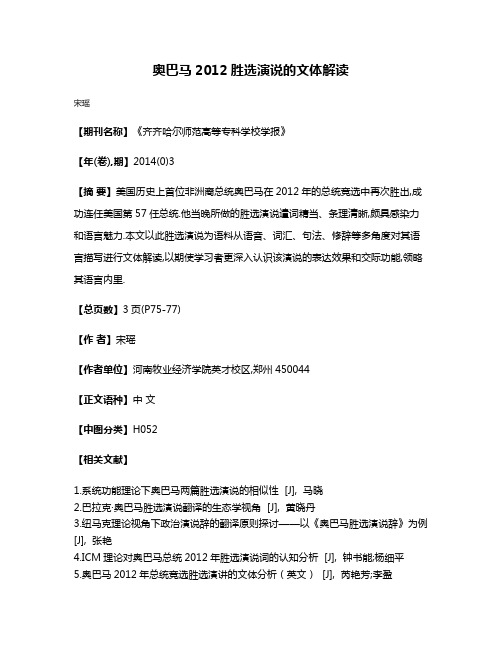
奥巴马2012胜选演说的文体解读
宋瑶
【期刊名称】《齐齐哈尔师范高等专科学校学报》
【年(卷),期】2014(0)3
【摘要】美国历史上首位非洲裔总统奥巴马在2012年的总统竞选中再次胜出,成功连任美国第57任总统.他当晚所做的胜选演说遣词精当、条理清晰,颇具感染力和语言魅力.本文以此胜选演说为语料从语音、词汇、句法、修辞等多角度对其语言描写进行文体解读,以期使学习者更深入认识该演说的表达效果和交际功能,领略其语言内里.
【总页数】3页(P75-77)
【作者】宋瑶
【作者单位】河南牧业经济学院英才校区,郑州450044
【正文语种】中文
【中图分类】H052
【相关文献】
1.系统功能理论下奥巴马两篇胜选演说的相似性 [J], 马晓
2.巴拉克·奥巴马胜选演说翻译的生态学视角 [J], 黄晓丹
3.纽马克理论视角下政治演说辞的翻译原则探讨——以《奥巴马胜选演说辞》为例[J], 张艳
4.ICM理论对奥巴马总统2012年胜选演说词的认知分析 [J], 钟书能;杨细平
5.奥巴马2012年总统竞选胜选演讲的文体分析(英文) [J], 芮艳芳;李盈
因版权原因,仅展示原文概要,查看原文内容请购买。
- 1、下载文档前请自行甄别文档内容的完整性,平台不提供额外的编辑、内容补充、找答案等附加服务。
- 2、"仅部分预览"的文档,不可在线预览部分如存在完整性等问题,可反馈申请退款(可完整预览的文档不适用该条件!)。
- 3、如文档侵犯您的权益,请联系客服反馈,我们会尽快为您处理(人工客服工作时间:9:00-18:30)。
奥巴马2012年国情咨文互文性分析摘要:“互文性”概念在20世纪60年代提出以来,在文学和文化研究、翻译和语言学领域得到广泛的运用,从而演变成一种重要理论。
互文性手段运用于演讲语篇中,有助于演讲目的顺利实现。
关键词:互文性;语篇分析;奥巴马2012年国情咨文中图分类号:h319 文献标识码:a 文章编号:1006-026x(2012)08-0000-0220 世纪 60 年代后期,法国符号学家克里斯蒂( kristeva)首先提出了“互文性”( intertextuality)这一概念[1]。
自产生后,它在翻译以及文学研究中得到广泛的运用,语篇语言学家将其引入语篇分析,认为每一个语篇都是对以前语篇在形式和内容上的继承和发展,将文本与文本之间的互涉、互动看成语篇的基本构成因素。
一、理论回顾“现代语言学之父”索绪尔本人很重视语言符号之间的关系,然而一旦到分析语篇的时候,索氏总是倾向于把语篇看成是一个相对封闭的系统。
前苏联学者巴赫金认为索绪尔关于语言言语的区分很明显忽视了社会,因此他提出了自己的对话理论。
法国学者克里斯蒂娃综合了索绪尔结构主义语言学与巴赫金的文学理论,克里斯蒂娃首先在“the bounded text”一文中提出了“互文性”这一概念。
她指出[2],一个语篇的产生是建立在已经存在的语篇基础之上的,一个语篇并不是作者对自己原创思想的写照而是对先前存在的语篇的编辑和整理。
这样一来,每个语篇都存在于与其他语篇的关系中,所有语篇都是由其他语篇构成的;一个语篇的意义与其说是由其作者构造的不如说是由其互文性构建的。
互文理论提出后,罗兰·巴特,布鲁姆、德里达、等人对其进行了补充和发展。
至于互文性的分类,本文采取费尔克劳(fairclough)的框架—明示互文性(manifest intertexuality)和建构互文性(constitutive intertexuality)[3]。
前者是指特定的其他文本公开地被利用到一个文本之中,如有引号、明确标示或暗示的(包括引用,模仿用典等);后者则指按照各种体裁或语篇类型来建构一个文本(包括语域、体裁、风格等)。
本文使用赵军(2008)的框架,如下:二、语篇背景按照美国惯例,每年年初,现任总统都要在国会做年度报告,阐述政府的施政方针,被称为“国情咨文”。
奥巴马是美国历史上第一名非洲裔黑人总统,从参政开始,他就以睿智的反应,激情的演讲,和蔼可亲的态度赢得了广大美国选民的好感,是一名不折不扣的天生演说家。
本文的演讲是美国总统奥巴马在其任内的第三篇国情咨文。
三、明示互文性的作用这篇国情咨文主要使用了指示(reference)、引用(quotation)、用典(allusion)等。
(一)指示:最为常见的互文性手段之一,一般是语篇生成者为了使语篇易懂且具有说服力使用的方法。
1.at the end of world war ii,when another generation of heroes returned home from combat,they built the strongest economy and middle class the world has ever known.my grandfather,a veteran of patton’s army,got the chance to go to college on the gi bill.my grandmother,who worked on a bomber assembly line,was part of a workforce that turned out the best products on earth.上面例子中,奥巴马总统提及“二战后美国重建“,“自己的祖父祖母”,对象涉及过去的经历,特殊人物等。
二战后美国经济等方面的重建成功,以及奥巴马祖父祖母在美国诺言的信念下努力工作的事迹无疑是对美国民众的一个极大激励。
2.in the last 22 months,businesses have created more than3 million st year,they created the most jobs since 2005.american manufacturers are hiring again,creating jobs for the first time since the late 1990s.together,we’ve agreed to cut the deficit by more than 2 trillion.3.today,general motors is back on top as the world’s no.1 automaker.chrysler has grown faster in the u.s.than any major car company.例2中,奥巴马当政期间就业和财政赤字方面所取得的成就被提及,并且辅以具体的数字加以证明。
在例3中奥巴马又提到“通用汽车”、“克莱斯勒”等大公司及他们所获得的荣誉以成就。
这些指示现象宣传了奥巴马的政绩。
(二)引用包括直接引用与间接引用,同时也有引用自己的话和他人的话之分。
4.today,it’s hiring workers like bryan,who said,”i’m proud to be working in the industry of the future.”5.one of the young men involved in the raid later told me that he didn’t deserve credit for the mission.it only succeeded,he said,because every single member of that unit did their job - the pilot ...;the translator...;the troops ...;the seals ....例4是直接引用布莱恩的话,来说明发展清洁能源是国家的未来。
例5中是对一位参加突袭行动的年轻人的话语的间接引用,指出战争中的任何一项任务是大家团结一致完成的。
奥巴马旨在鼓励美国民众团结起来,共同参与美国各方面的建设。
(三)用典:用典的使用是为了使文章简单易懂,增强文章的可读性和说服性。
6.it means we should support everyone who’s willing to work;and every risk-taker and entrepreneur who aspires to become the next steve jobs.国情咨文的对象是美国国会和美国民众,奥巴马在演讲中提到史蒂夫·乔布斯——著名的发明家、企业家、美国苹果集团的联合创始人和前行政总裁。
篇章的接受者知识结构中储存着这类信息,了解演讲者的典故,从而形成互文连接。
四、建构互文性作用对于建构互文性来说,这篇国情咨文主要使用了功能互文性(functional intertextuality)、体裁互文性(generic intertextuality)、修辞互文性(rhetorical intertextuality)等。
(一)功能互文性:奥巴马的这次演讲在目的上和历年国情咨文一样,主要是:1)向议会和美国大众报告上一年所取得的成就以及来年的计划;2)宣传总统的提议以争取议会的通过和大众的认可和支持;3)激励大众,鼓励大众响应总统的号召。
(二)体裁互文性:体裁互文性指的是语篇中不同风格、语域或体裁特征的混合交(辛斌,2002)。
奥巴马的这篇国情咨文里描写,记叙,宣传等元素混合交融,共同促进交际目的实现。
奥巴马在回顾发展时,肯定方面的引用比消极方面多,在描述国情时加入了宣传元素。
同时,演讲中记叙了普通人的故事,这些记叙元素使演讲更加人性化,更能使听众信服。
(三)修辞互文性:指修辞手法的使用,国情咨文中通常大量使用排比,增加文章的气势。
7.that’s why my education reform offers more competition,and more control for schools and states.that’s why we’re getting rid of regulations that don’t work.that’s why ourhealth care law relies on a reformed private market,not a government program.五、结语互文性是指两个或两个以上的文本之间的联系之间的相互映射关系(王燕星,2006)。
在2012年的这篇国情咨文里,奥巴马巧妙地运用互文性手段,调动听众大脑里面的知识储存,从而引起注意,加深印象,实现了国情咨文宣传、劝服、激励等交际目的;而且各种互文手段的运用使整个演讲富有激情和感染力,政治说理和情感沟通并存,是一次极具个人魅力和美学效果的演讲。
参考文献:[1] kristcva,j.the kristeva reader[c].oxford blackwel1,1986.[2] 吕行.互文性理论研究浅述[j].北京印刷学院学报,2011,(19):46-49.[3] fairclough,n.discourse and socialchange[m].cambridge:polity press,1992:106.[4] 赵军.语用学论文摘要的互文分析[d].湘潭大学硕士论文,2008:14.[5] 辛斌.体裁互文性的社会语用学分析[j].外语学刊,2002,(2):15—21.[6] 王燕星.浅析互文在广告中的运用[j].福建教育论坛(社科教育版),2006(专刊):55—57.。
